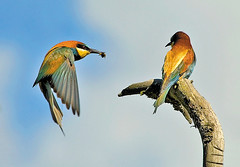

Images: jcoelho and La Lince, on Flickr
Try these websites for some basic natural history information, but remember that you can't cite websites. Instead, use these as a starting point. Look at the sources they cite and see if you can find those sources in LibrarySearch.
Search your species name on Wikipedia. There might be an overview of the species' natural history and some background information to get you thinking. Some of the links cited in Wikipedia might even be useful in your research!
Note: Use wikipedia to find resources, but don't cite wikipedia itself! (See "Using Web Resources" on the left).
You can find very reliable - and easily cited - natural history information in articles published in scientific journals. Search your species name and look at any of the articles that come up. Even if you are not interested in the topic that the article discusses (maybe you can not even understand it!), you should check the Introduction, Methods, and Discussion sections for information on your species. For species which aren't as well-studied, journal articles might be the most comprehensive source of natural history information.
See Finding Journal Articles for tips to get started.
To find articles: from the U of T library homepage, you can search using either the advanced search option or through subject specific databases.

The advanced article search allows you to use keywords. By narrowing down your search results using the facets on the left hand side, you can find relevant articles. Also, if you know the specific details of the article you are looking for, such as volume, issue and/or title, this is where you can search for it.

It is likely that you will receive an overwhelming amount of results, but by selecting the appropriate search filters, format and subject options, you can narrow down your results.
To find the most useful databases for your subject, click on "Databases" from the UTL library homepage, then select "Article databases by subjects A-Z", and then choose a subject from the list. For example, if we select "Biology" from this list, we see key biology and multidisciplinary databases such as BIOSIS, Scopus, and Web of Science. This can also lead you to other resources such as dictionaries, encyclopedias, and the Ecology and Evolutionary Biology Resource Guide.


Encyclopedias are another great resource for finding natural history information. Check out these encyclopedias from the University of Toronto that are written and edited by experts in the field.
Books are another great resource for Natural History information. Information found in books is reliable and complete; however, it may not be the most recent.
Textbooks are another great resource, for both natural history information and summaries of previous research. Textbooks are especially good for finding information on concepts you are going to include in your report.
University of Toronto Libraries
130 St. George St.,Toronto, ON, M5S 1A5
libraryhelp@utoronto.ca
416-978-8450
Map
About web accessibility. Tell us about a web accessibility problem.
About online privacy and data collection.
© University of Toronto. All rights reserved. Terms and conditions.
